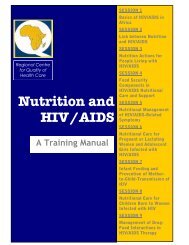2.1: Anthropometric Indicators Measurement Guide - Linkages Project
2.1: Anthropometric Indicators Measurement Guide - Linkages Project
2.1: Anthropometric Indicators Measurement Guide - Linkages Project
You also want an ePaper? Increase the reach of your titles
YUMPU automatically turns print PDFs into web optimized ePapers that Google loves.
COLLECTING AND ANALYZING THE DATA PART 3.<br />
and hire staff is planned at this point.<br />
Other needs such as office space and<br />
equipment are also considered and<br />
planned. Specific equipment is needed to<br />
do anthropometric assessments as part of<br />
a survey and is discussed in Part 4.<br />
• Select the sample.<br />
Once the survey<br />
goals and methods of collecting the<br />
information have been decided, the groups<br />
and numbers of people to be interviewed<br />
are selected. A sample is a small part of<br />
the group being studied that has been<br />
chosen to represent the whole group.<br />
There are special considerations when<br />
choosing a sample for anthropometric<br />
assessment. Sampling is discussed in<br />
Appendix 3 and the reader is referred<br />
to the FANTA Sampling <strong>Guide</strong>.<br />
(www.fantaproject.org/publications)<br />
• Develop the questionnaire. The list of<br />
essential information needed to meet the<br />
survey objectives forms the basis of the<br />
survey questionnaire. A standard, printed<br />
questionnaire ensures that all the<br />
respondents are asked the same questions<br />
and enables the survey responses to be<br />
tabulated easily and quickly. The<br />
questionnaire may need to be translated<br />
into local languages. Translated<br />
questionnaires should be translated back<br />
to the original language by another<br />
translator and compared to the original<br />
questionnaire. Enumerators need to be<br />
trained in the appropriate use of the<br />
translation. See Figure 5.4 for a sample<br />
questionnaire.<br />
• Pre-test the questionnaire. Before the<br />
questionnaire is finalized it should be<br />
tested for content and length; the<br />
questions should gather the needed<br />
information and should be easily<br />
understood by both interviewers and<br />
respondents. In the pre-test a small<br />
number of interviews are conducted and<br />
the questionnaire is revised on the basis of<br />
these results and comments from the<br />
interviewers.<br />
• Train personnel. Training of field staff<br />
is a vital step in the survey process;<br />
accurate, meaningful information can be<br />
collected only if interviewers thoroughly<br />
understand all their field instructions and<br />
procedures. When all the field materials<br />
have been prepared and finalized, and the<br />
field staff has been hired, all interviewers<br />
and supervisors should be brought to a<br />
central location to be taught survey<br />
procedures, how to collect the data and<br />
how to use the questionnaire. When<br />
anthropometric assessment will be part of<br />
the survey, correct methods for taking<br />
measurements should also be part of the<br />
training schedule. If the actual survey is<br />
delayed for more than three weeks<br />
following training, it will be necessary to<br />
retrain personnel.<br />
• Standardize the anthropometric<br />
technique. The training of personnel on<br />
specific measurement and recording<br />
techniques should include not only<br />
theoretical explanations and demonstrations,<br />
but also provide an opportunity<br />
for participants to practice the measurement<br />
techniques, as well as reading and<br />
recording the results. Once all personnel<br />
have adequately practiced the measurement<br />
and recording techniques, and feel<br />
comfortable with their performance,<br />
standardization exercises should be<br />
carried out to ensure that all interviewers<br />
acquire the skills necessary to collect high<br />
quality data. Details of these exercises are<br />
presented in Appendix 6.<br />
• Interview. The success of a survey<br />
depends on the quality of the field<br />
procedures, supervision and interviewing.<br />
Interviewers should follow sampling and<br />
interviewing instructions precisely and<br />
accurately. They need to keep in touch<br />
with their field supervisor and bring any<br />
problems or difficulties to their attention.<br />
• Supervise the data collection. Once<br />
the interviewing begins, field supervisors<br />
should be present to assist interviewers<br />
with problems that may arise in finding<br />
the correct households, conducting the<br />
interviews or completing the work on<br />
time. Field supervisors, in addition to<br />
solving field problems, are responsible for<br />
distributing materials, reviewing and<br />
checking completed questionnaires and<br />
3.<br />
15

















